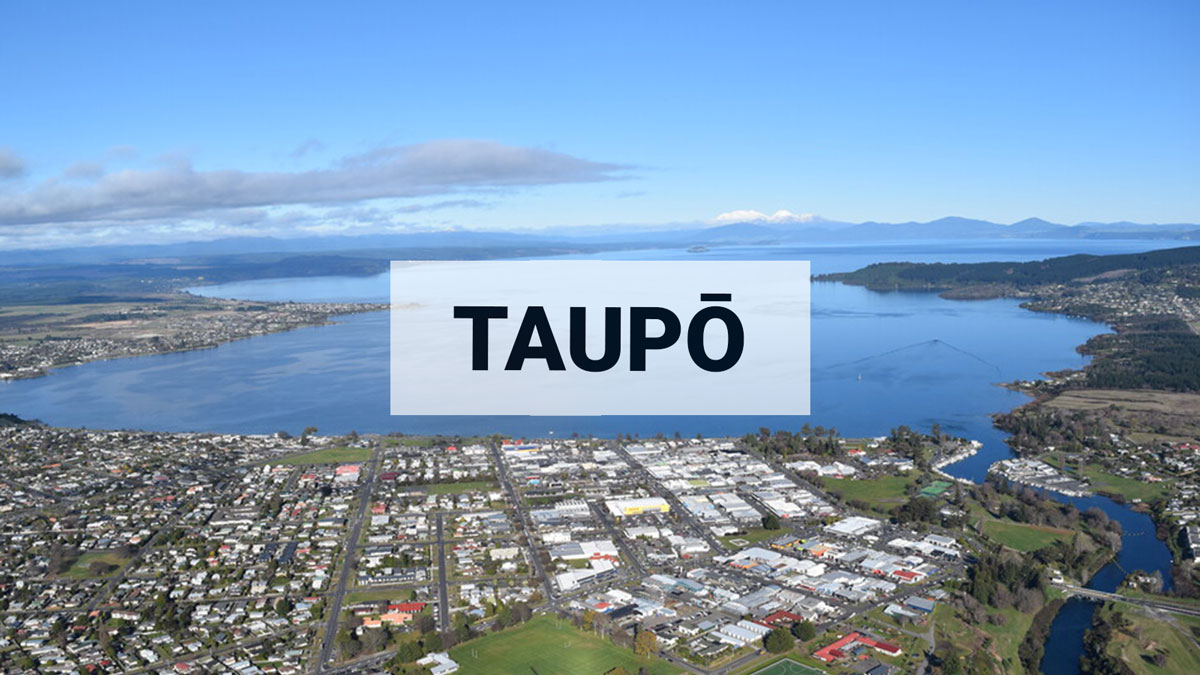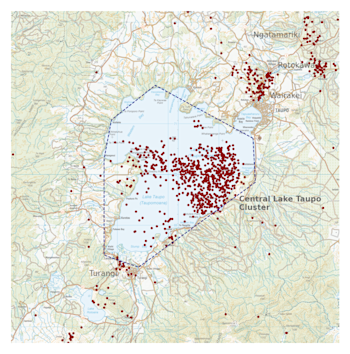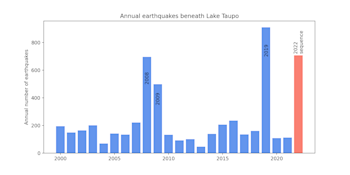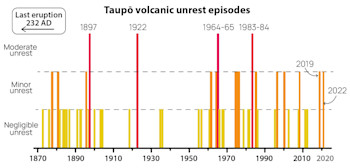National Advisory: Tsunami activity – expect strong and unusual currents and unpredictable surges at the shore following the M8.7 earthquake, Kamchatka Russia. For all information please visit NEMA (The National Emergency Management Agency) Only messages issued by NEMA represent the official warning status for New Zealand.

Taupō Volcano: Volcanic Alert Level raised to Level 1. Ongoing earthquakes and deformation indicating minor volcanic unrest
The Volcanic Alert Level for Taupō Volcano is raised to Volcanic Alert Level 1 (minor volcanic unrest). The minor volcanic unrest is causing the ongoing earthquakes and ground deformation at Taupō Volcano.
GNS Science, through the GeoNet programme, continually monitors Taupō volcano and our other active volcanoes for signs of activity. There has been an increase in earthquakes and deformation (ground movement) at Taupō since May 2022 indicating volcanic unrest is occurring. The Volcanic Alert Level (VAL) change this week has been informed by our ongoing analysis of monitoring data, increased knowledge of Taupō Volcano from research programmes and new knowledge of causes of past unrest at Taupō Volcano.
Although this is the first time we have raised the VAL to 1, this is not the first volcanic unrest at Taupō. There have been 17 previous episodes of unrest over the past 150 years. Several of these were more severe than what we are currently observing at Taupō. None of these episodes, or the many other episodes which would have occurred over the past 1800 years before written records were kept, ended in an eruption. The last eruption at Taupō volcano was in 232 AD ± 10 years. The chance of an eruption at Taupō remains very low in any one year.
The earthquakes and deformation could continue for the coming weeks or months. While some of the earthquakes may be felt in areas around Lake Taupō, the deformation is currently only detectable by our sensitive monitoring instruments. GNS Science continues to actively monitor the volcano.
What our monitoring data are telling us
As you may have read in our last Volcanic Activity Bulletin on Wednesday 14 September, the earthquake sequence beneath the central part of Lake Taupō has continued. We have now located almost 700 earthquakes, mainly at a depth of 4 to 13 km beneath the lake (Figure 1).
The earthquake locations in this year’s sequence are forming two clusters in the central part of the lake. There is a cluster beneath the central and eastern part of the lake and a smaller, western cluster centred just offshore from Karangahape. Shown in Figure 2 is the number of earthquakes detected and located each year since 2000 in the dashed area outlined in the map (Figure 1).

Figure 1: Earthquakes located by GeoNet in the Lake Taupō area from January 1 to September 18, 2022. Most earthquakes shown here were located between 4 and 13 km deep. There are almost 700 earthquakes shown within the dashed area of the map. There are also clusters of small earthquakes at geothermal fields in the Taupō area that are unrelated to the Taupō volcanic unrest.

In addition to seismic activity, GeoNet continuously monitors ground deformation (land movement) about Lake Taupō. Our GNSS (GPS) instruments around the lake have observed uplift at a rate of 60 ± 20 mm per year since May 2022 at a site at Horomatangi Reef in the lake. Modelling of the GNSS data indicates that the area that is rising beneath the lake is in the same place as the main region of earthquake activity. This is also where we interpret the existing magmatic system to be located.
We interpret the ground uplift and earthquake activity to be caused by the movement of magma and the hydrothermal fluids inside the volcano. We have also sampled springs and gas vents around the lake for changes in chemistry that may be related to the earthquake and ground uplift.
What does volcanic unrest mean?
Volcanic unrest is when magma or magma-heated hot water and steam forces its way through the ground beneath a volcano, producing earthquakes, ground movement and changes in hydrothermal systems. There have been 17 previous episodes of unrest over the past 150 years at Taupō Volcano (Figure 3).
Episodes of unrest are common at calderas around the world. Volcanic unrest at volcanoes like Taupō could continue for months or years and not result in an eruption. If there was increased unrest, then we would see more substantial impacts on the local area. These could include earthquakes with ground shaking and potentially landslides on steep cliffs, especially after rain. Liquefaction can occur in the event of larger earthquakes. Substantially higher levels of ground deformation, 10s of centimetres or metres, would only occur at higher unrest levels, but could have impacts such as damaging underground services. Changes in geothermal activity may also occur with stronger, evolving unrest. This could be beneath the lake or at established geothermal areas in the Taupō area.
The Volcanic Alert Level reflects the current level of volcanic unrest or activity and is not a forecast of future activity. While Volcano Alert Level 1 is mostly associated with environmental hazards, potential for eruption hazards also exists. Further information about the Volcanic Alert Levels and what they mean can be found here. More information about caldera unrest can be accessed from this report.
We acknowledge the contribution of colleagues from Te Herenga Waka - Victoria University of Wellington in analysis and interpretation of some of the Taupō data.
Although we can’t prevent natural hazards, we can prepare for them – and we should.
For information on preparing for earthquakes or responding to volcanic activity, there are guidelines from the National Emergency Management Agency's Get Ready website.
More information about Civil Defence in the Taupō District can be found here.
The Tūwharetoa Māori Trust Board (CEO Rakeipoho Taiaroa) is closely involved in discussions as the landowner of Lake Taupō. More information about the Trust can be found at: https://www.tuwharetoa.co.nz/
Find out more about Taupō Volcano
How do we monitor our volcanoes?
Earthquakes can occur anywhere in New Zealand at any time. In the event of a large earthquake: Drop, Cover and Hold.
Steven Sherburn Duty Volcanologist
Media Contact: 021 574541 or media@gns.cri.nz




